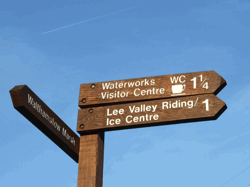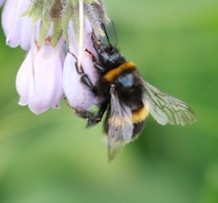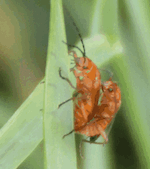 |
|
| |||||
THE INSECTS ON WALTHAMSTOW MARSHES | |||||
|
The most successful group of creatures in the world is insects. It is not surprising therefore to discover something in excess of 800 different species living, feeding and breeding on the Marshes. One of the most outstanding discoveries has been the naming of 17 plus butterflies breeding year after year on Walthamstow Marshes. The webs of the Small Tortoiseshell caterpillar can be seen in the early Spring on even the smallest clump of nettle. Nettle also supports butterflies like the beautiful Peacock, with its staring eye spot on each wing and a rich, deep red ground colour. The Marshes are also an important breeding ground for the Essex Skipper who, in spite of loss of habitat in other locations, is on the increase at Walthamstow. Even the lowly Small White flits erratically across the plants like a fairy messenger. On every ear and stalk of grass, on every Dock or Common Mallow, each Ragwort and Bulrush, lives one kind of insect or another. The Roesel's Bush Cricket is another success story. Two years ago there was a small colony of about 30 individuals on the very edge of Walthamstow Marshes and nowhere else for miles but at the beginning of August 1979 I heard, then spotted, three males and one female, separately and a mating pair, close to the footpath by the copse of Sallow on Walthamstow. The Roesel's Bush Cricket is quite restricted in this country, mainly to southern Kent, north and central Norfolk, southern Hampshire and the Isle of Wight. The Roesel's song is truly beautiful, second only to one or two other species of cricket or grasshopper. The great pirate of the insect world must be the Emperor Dragonfly, hovering and darting along the Lea and Coppermill stream like a small helicopter. It has been likened to the Red Baron of insects, as it feeds on the wing. I have also noted at least five damselflies along the Coppermill backwater. These have to stay quite close to water as they are not as strong flyers as their larger cousins and, like dragonflies, are aquatic in their larval stage. Coppermill stream is also the home of many water bugs and beetles: Pondskaters and Backswimmers, Lesser Diving Beetles and Whirlygig Beetles thrive there. I have noted 11 different Hoverflies on the Marshes; with their beautiful black and yellow bodies, they are perfect mimics of wasps and bees. When you get a chance, watch them while they hover; their wings beating at about a thousand times a second are just a blur, as the fly remains perfectly still in mid air. Along with the rest of the True Flies (those with two wings) they are nature's refuse men, breaking down decaying organic matter as larvae, once any juices have been removed by the adult. Without a doubt, the largest number of individuals in one group, is Hymenoptera, which consists of Wasps, Bees and Ants. I have discovered 54 underground Bees' nests on the Marshes but have no fear for these are well away from paths and are quite hard to find, for bees are basically shy and reserved creatures, as are Ants, whose nests on the Marshes are quite big; the largest I have seen was spread over several square feet. As for Wasps, I have noted 23 different species; mostly these have been Solitary Wasps and Ichneumons; only three were hive builders. During high Summer I would estimate the total bee and wasp population outnumber the population of Hackney three to one.  
I have even sighted Honey Bees, both wild and domesticated. The wild bees, although the same species as the domestic variety are slightly smaller. This must be due to the hit and miss factor of obtaining nectar from the same plant type, along with surviving with no home made for them by man. There exists a rather silly insect, the Soldier Beetle. These are so funny for although they hate being handled, it takes several seconds for them to realise they are not on their foodplant. There are hundreds of these beetles comically falling around. They remind me of an inexperienced tightrope walker, as they do tend to fall off their plants. I have noted only 17 different Beetles; I'm sure this low number is due to the fact that most beetles are nocturnal. This brings me to my greatest love in the insect world. Many people think that moths 'just eat your carpets and woolly jumpers', but these nocturnal arial ballet dancers are second only to bees in the pollination of flowering plants. Moths come in all shapes and sizes, from the 75mm (3in) wing span of the beautiful Eyed Hawk Moth with its black and orangey red eyespots on its hind wing, to the smallest pyralid that is drab brown with a wingspan of a 6mm (0.25in). In between, there exists for me the most fascinating and exciting group of insects. Any enterprising lunatic, who dares tread the Marshes at night, with a white sheet and hurricane lamp, can expect to get a visit from somewhere in the region of 20 different species. I have recorded 42 species in one night with just such equipment set up in the middle of Walthamstow Marshes. I have also baited moths with a mixture of treacle, sugar and a nip of rum. The moths do tend to get a bit drunk, but it is then, when they are perfectly still, you can study their shape, size and colour properly. The Walthamstow Marshes are my hunting ground, my insect laboratory, not to kill and pin then out for display, but to share their lives and to learn from them. To have this extraordinary piece of wild but very inhabited countryside, just ten minutes walk from my house, has increased my knowledge of insects a thousand fold. My love for nature, due almost entirely to the Marshes, has affected me so much that I am now planning to make Entomology, the study of insects, my future profession. Love of nature can only make someone more beautiful as a person, and a real possession is a thing to be valued. LET US PRESERVE OUR COUNTRYSIDE! Harry Britton. | |||||
 | Click to go to next section |